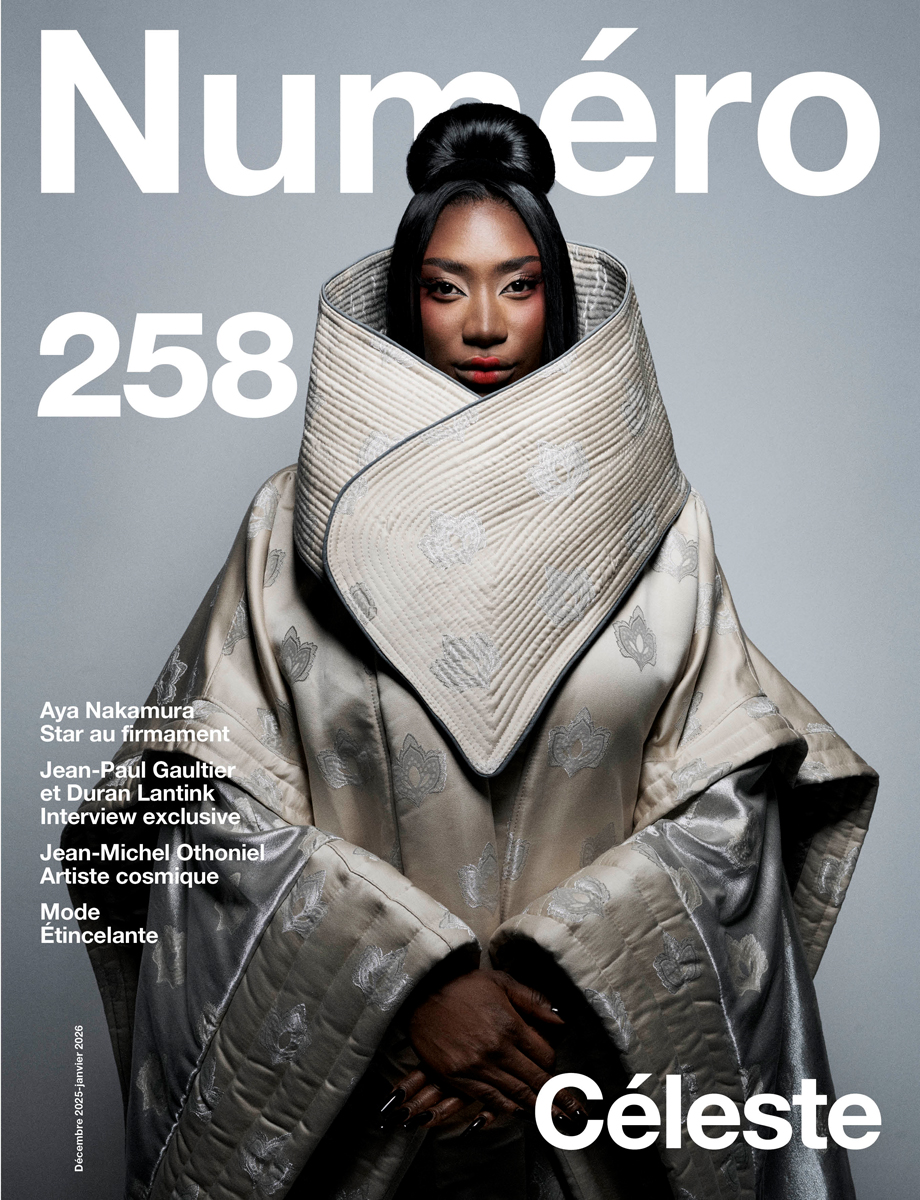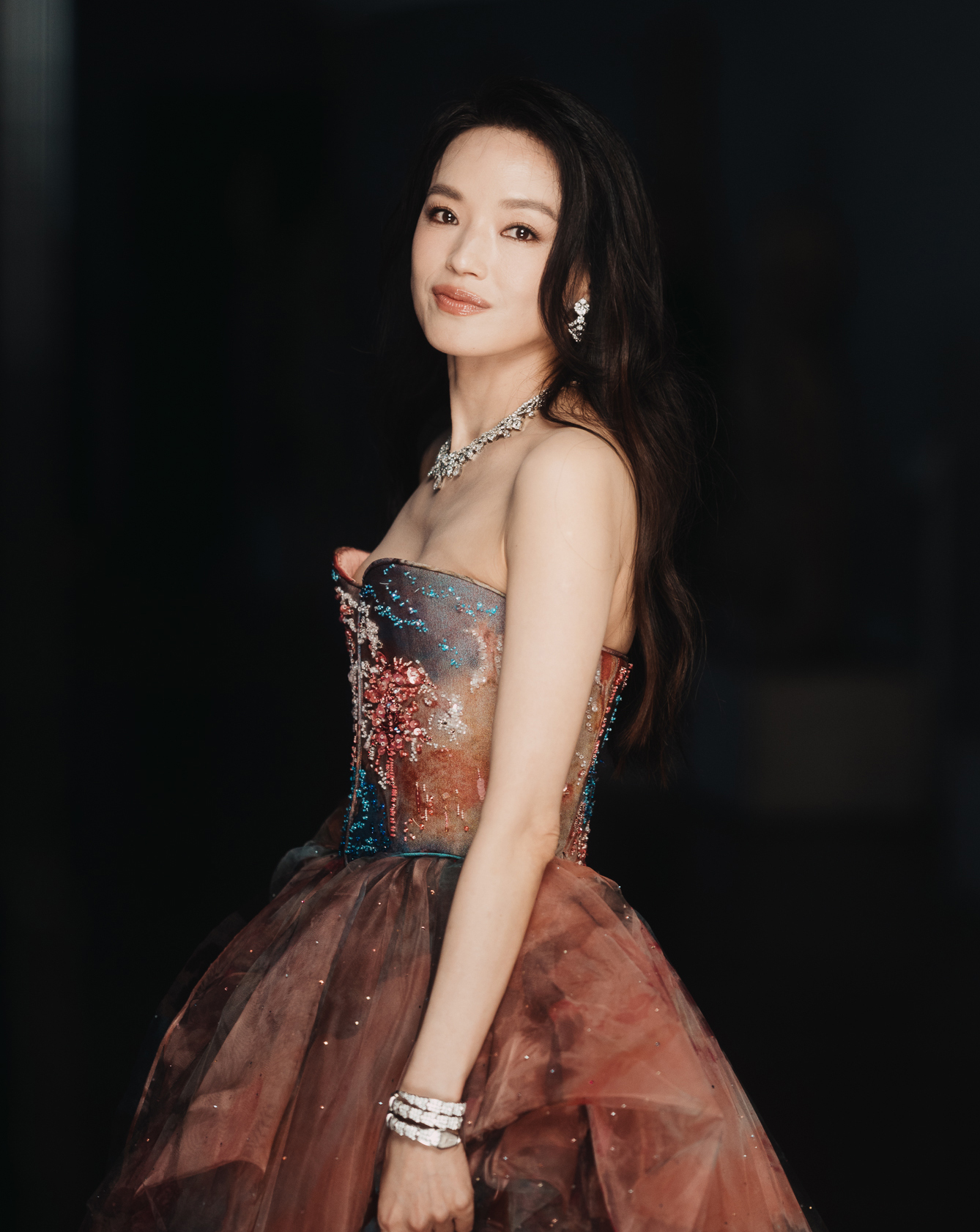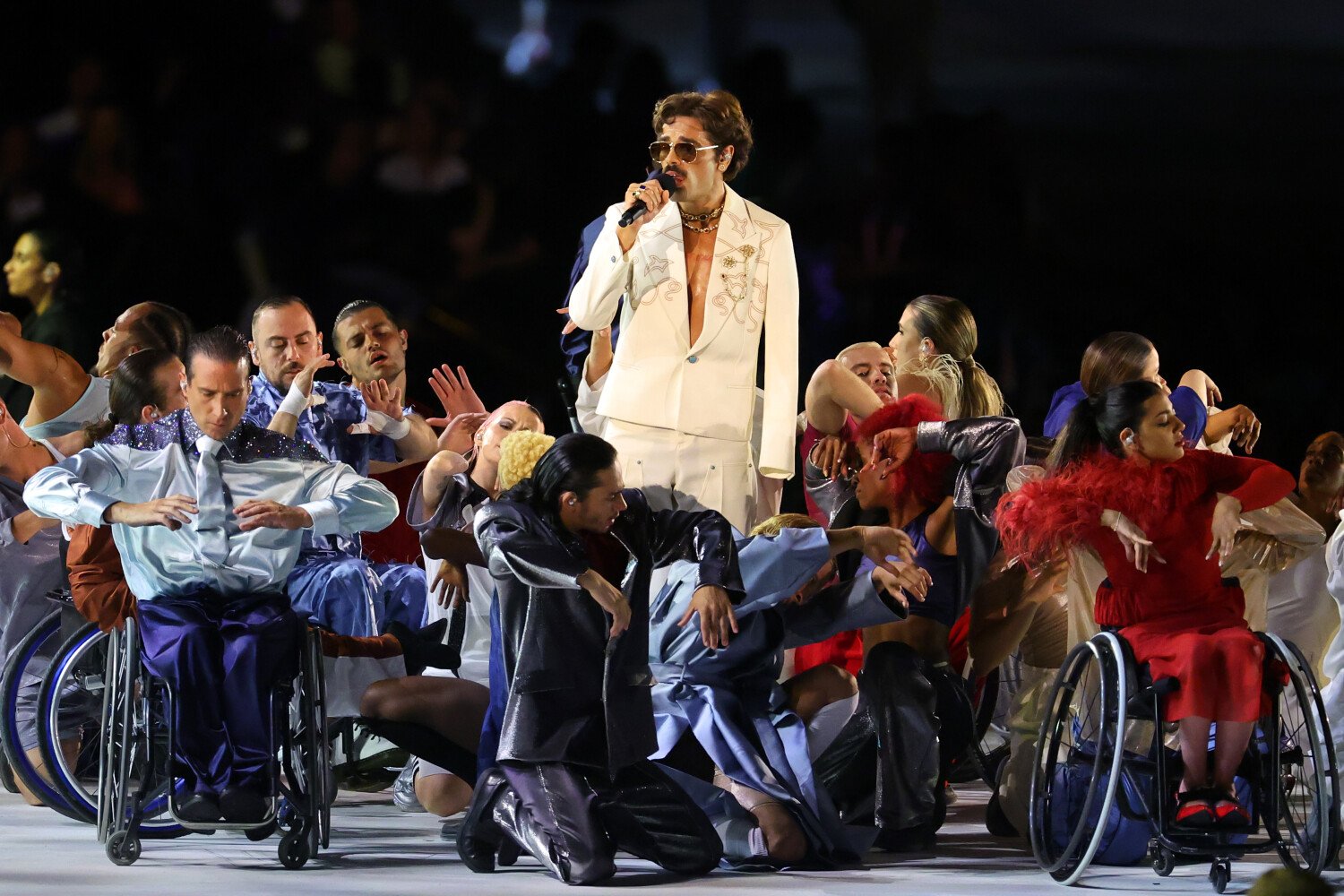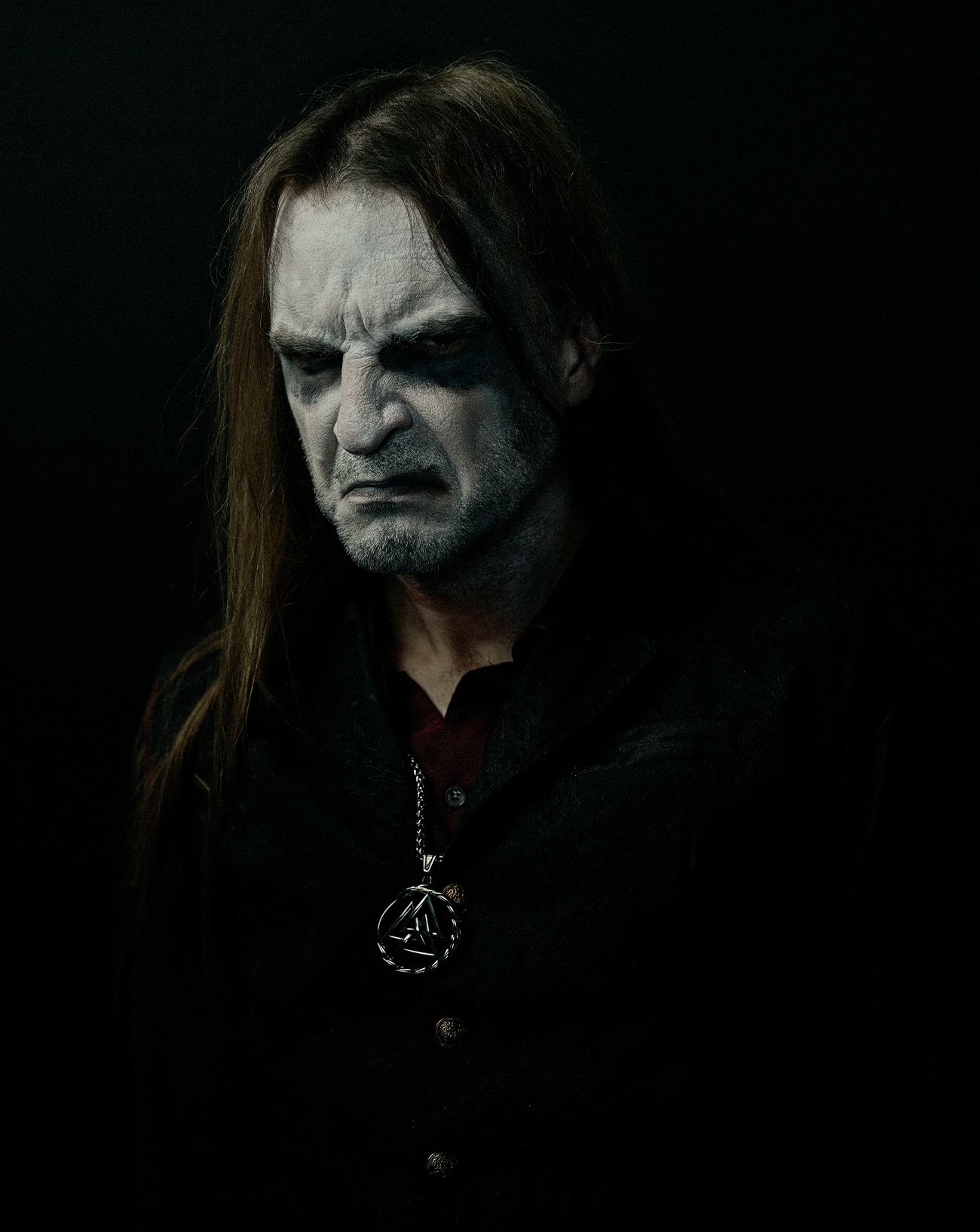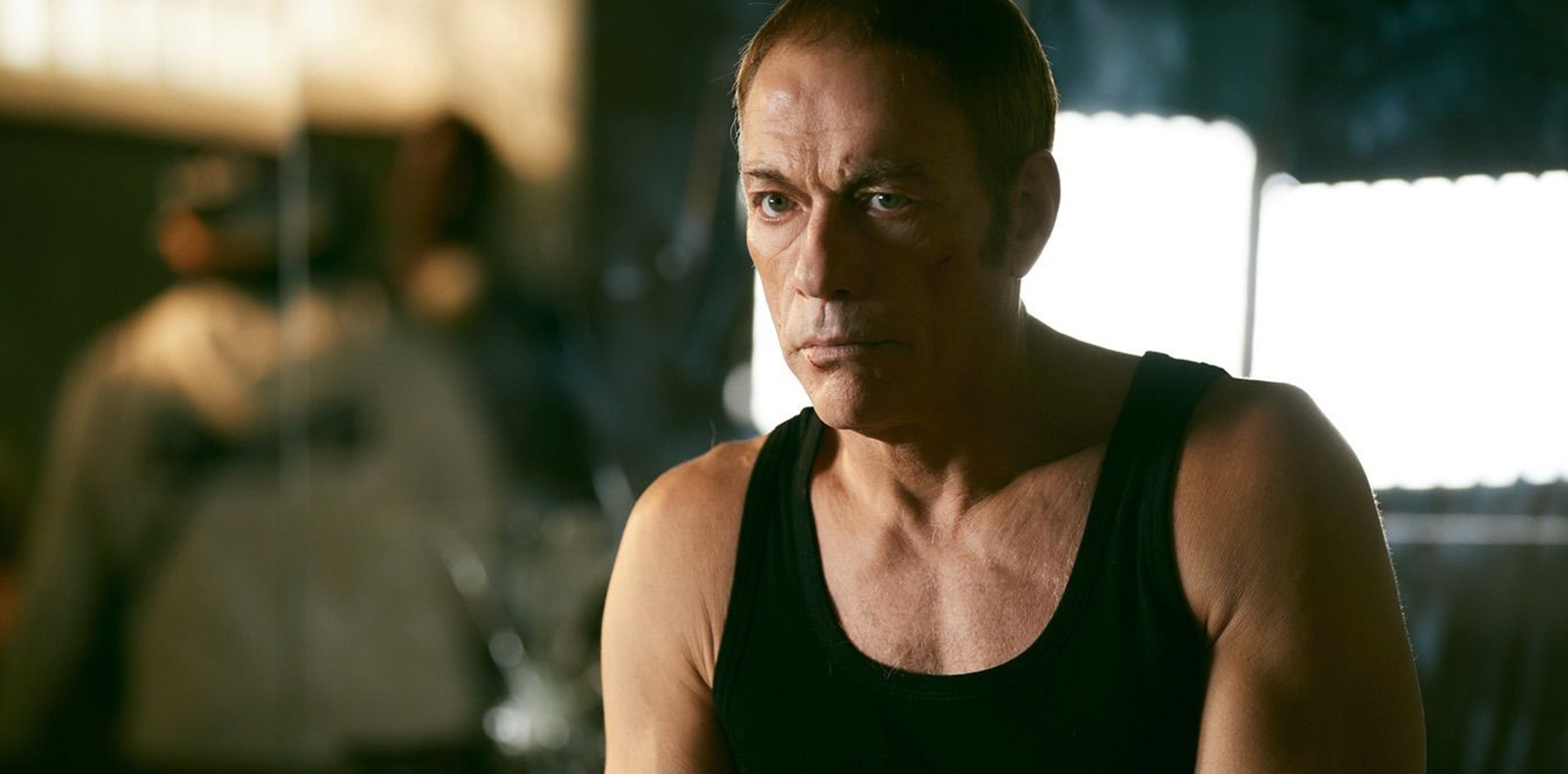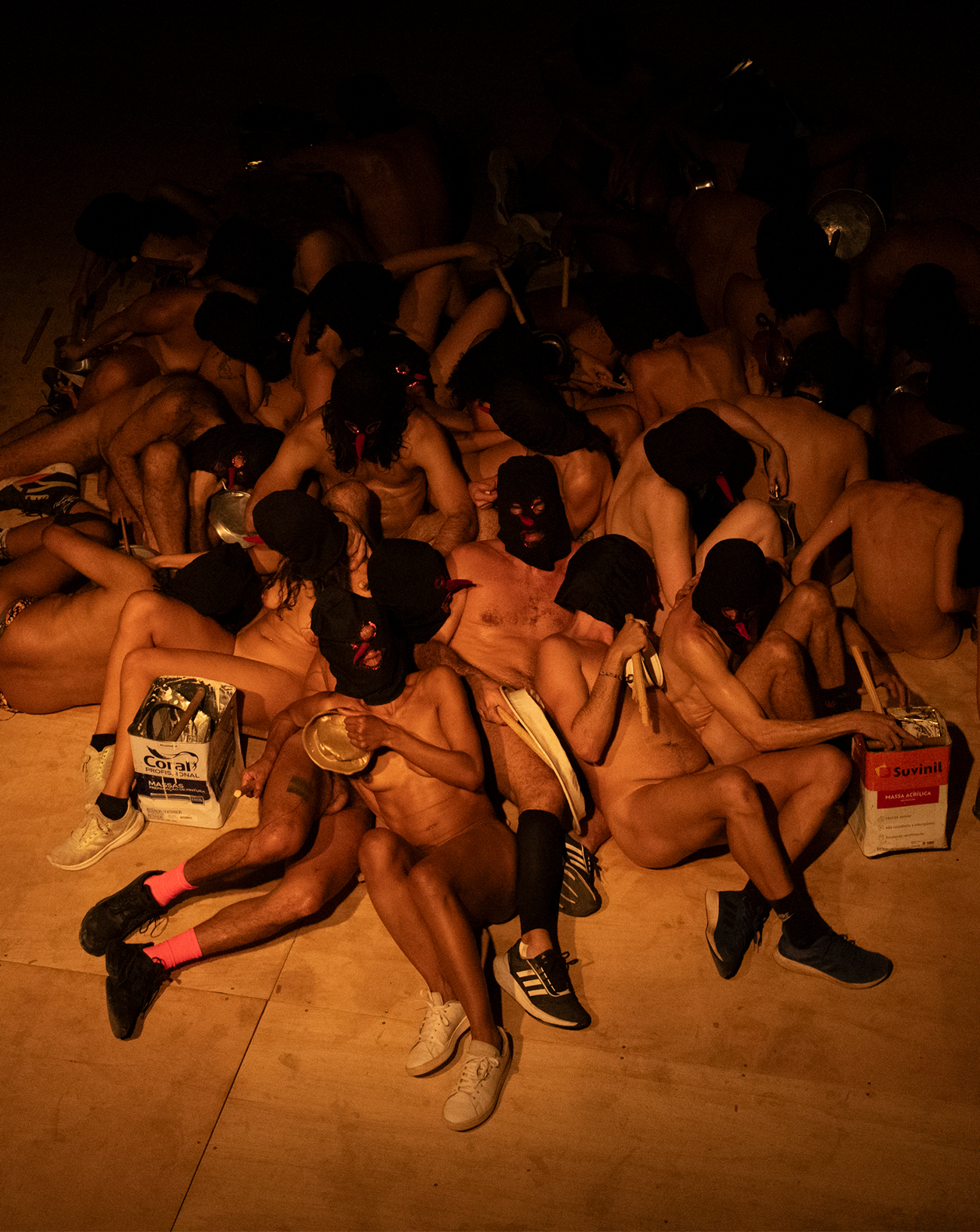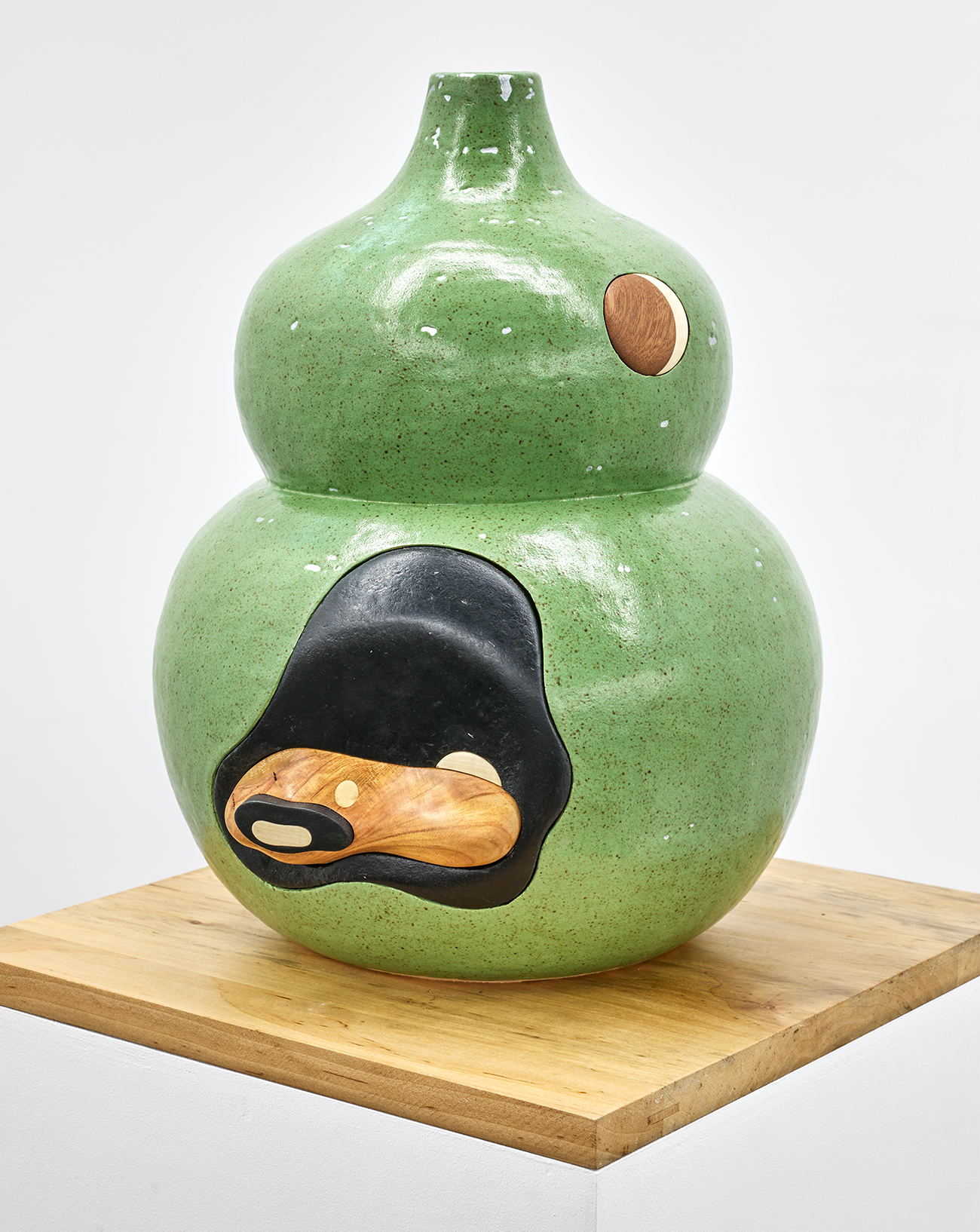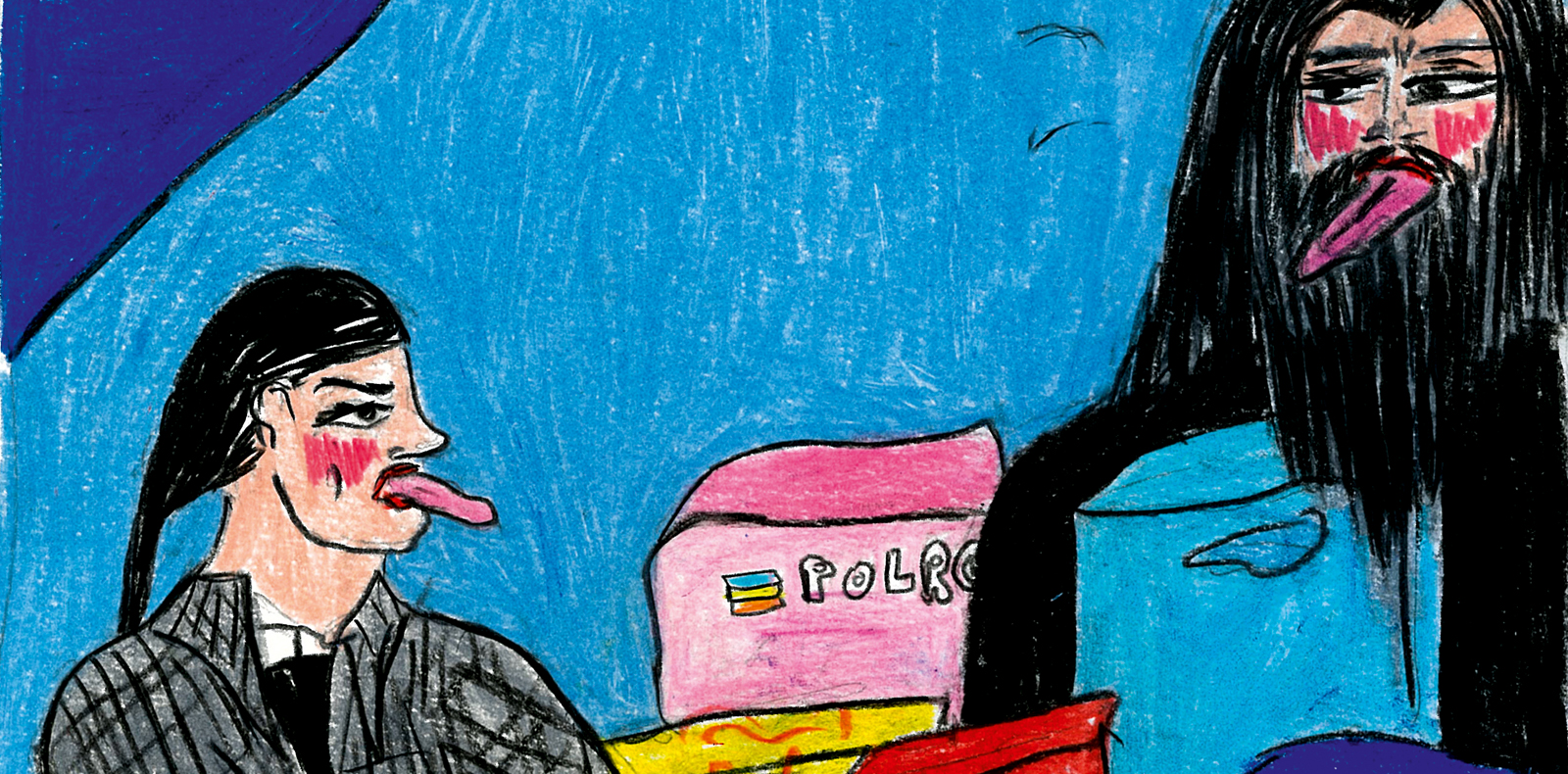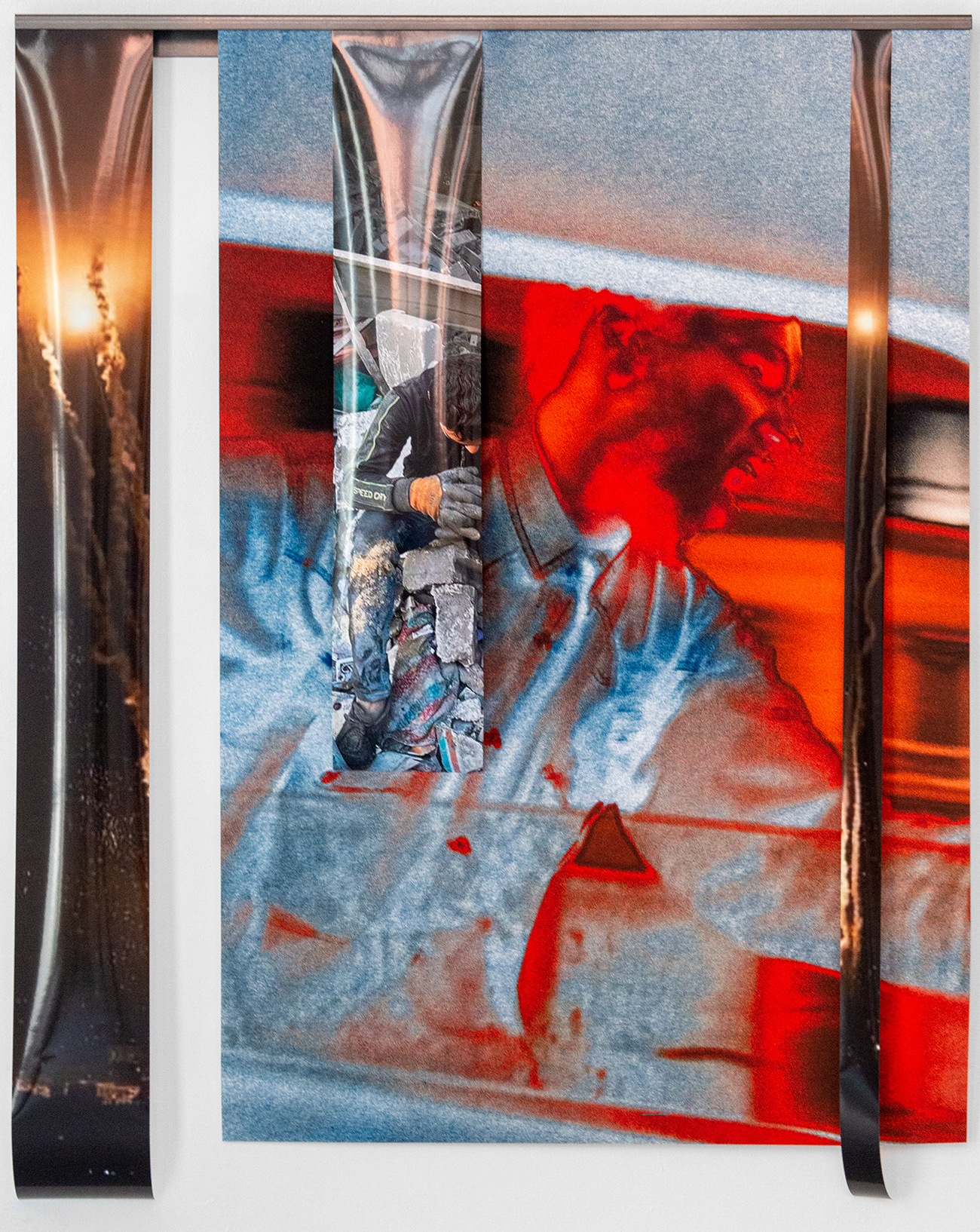
14

14
Rencontre avec Cyprien Gaillard, l’artiste à la double exposition magistrale au Palais de Tokyo et à Lafayette Anticipations
Numéro art célèbre en couverture Cyprien Gaillard, artiste majeur de la scène contemporaine consacré par le prix Marcel Duchamp en 2010. Le Français revient en force à Paris avec une double exposition magistrale à Lafayette Anticipations et au Palais de Tokyo. Obsédé par la ruine, la destruction et le passage du temps, le Français y dialogue avec d’autres artistes tels Giorgio De Chirico et Robert Smithson, et engage une réflexion sur le rapport du corps à l’architecture, entre effondrement et reconstruction. Il s’entretient avec sa commissaire d’exposition Rebecca Lamarche-Vadel.
Portraits par Marc Asekhame,
Propos reccueillis par Rebecca Lamarche-Vadel.

Rebecca Lamarche-Vadel : Pour préparer la double exposition HumptyDumpty, tu as sillonné inlassablement la ville de Paris en capturant des images autour de la tour Eiffel, de la Concorde, ainsi que de l’ensemble des monuments actuellement rénovés en perspective des jeux Olympiques de 2024.
Cyprien Gaillard : J’aime l’idée que nous sommes au moment où Paris fait son bilan entropique. C’est quelque chose qui m’a toujours intéressé, la manière dont les villes tentent de préserver certains édifices. Cette politique publique de restauration est inévitablement exclusive, elle ne peut pas inclure tout l’espace bâti… Une hiérarchie est déjà en place et définit les bâtiments et monuments à restaurer en priorité. Ce sont précisément ces limites que je veux explorer. J’ai toujours été intéressé par les failles. J’ai connu l’époque des jeux de billes où il fallait pousser une agate dans un trou, la fissure dans le sol était toujours pour moi un espace à viser, à investir. Ce motif de l’interstice revient souvent dans mon travail… Je crois que chaque artiste cherche un point d’entrée dans le monde qui l’entoure, une brèche où la lumière puisse passer. Avec notre environnement urbain de plus en plus rationalisé, normé, il y a de moins en moins d’espace libre où se projeter, où expérimenter autre chose que soi-même…
Le projet HumptyDumpty est imaginé comme une exposition en deux chapitres, avec un écho et une résonance entre le Palais de Tokyo et Lafayette Anticipations.
HumptyDumpty fait référence à un personnage de Lewis Carroll, issu d’une suite à Alice au pays des merveilles. Il est apparu avant, dans une comptine au 18e siècle. On raconte aussi que c’était le nom d’un canon. Chez Carroll, Humpty Dumpty est un œuf qui vit sur un mur de brique chancelant. Un jour, il tombe et se casse. Un effort collectif est alors réalisé pour le ramener à son état originel. Dans la comptine, il est expliqué qu’il est impossible de retrouver un tel état – “will never be put together again”. Même une fois raccommodé, il ne sera plus jamais comme avant. C’est l’idée de la spirale qui revient dans un mouvement similaire, comme les sillons d’un vinyle. Ce titre me paraissait particulièrement juste pour évoquer la grande campagne de restauration du centre de Paris en vue des jeux Olympiques, ainsi que tous les enjeux de destruction, mais surtout de préservation, qui y sont liés.

Tu as également décidé de rénover Le Défenseur du temps [une gigantesque horloge à automates de 4 mètres de haut et d’une tonne réalisée par l’artiste Jacques Monestier et installée en 1979 dans le quartier de l’Horloge, à Paris, ici présentée à Lafayette Anticipations].
Le Défenseur du temps était une réponse évidente à ton invitation. J’ai toujours voulu insuffler une nouvelle vie dans l’œuvre d’un autre. Je suis particulièrement intéressé par le sort réservé aux œuvres d’art publiques, surtout celles qui se retrouvent dans une forme d’anony- mat. Le Défenseur du temps est d’autant plus symbolique car il a été en mouvement, puis s’est arrêté. Je me rappelle l’avoir vu fonctionner, enfant, et avoir ressenti un grand sentiment d’étrangeté. C’était une énigme dont je n’arrivais à saisir ni la nature ni l’origine. Il n’était pas central puisqu’il était sur la route du Centre Pompidou, mais, aux yeux d’un enfant, il était bien plus intéressant que le musée. Je me souviens d’être passé dans cet espace interstitiel de nombreuses fois; c’est un passage piéton qui prête à la dérive. L’automate se trouve entre le Centre Pompidou et le musée des Arts et Métiers, mais il n’a sa place ni dans l’un ni dans l’autre, il existe dans un contre-espace comme dirait Foucault. Sans moi, je crois que ses jours étaient comptés : il y avait 300 kilos de fiente de pigeon à l’in- térieur du rocher et il menaçait de s’effondrer. Les questions de conservation architecturale, culturelle, ne sont intéressantes pour moi que quand on les lie à des questions de préservation des êtres, de soi. J’entretiens une relation émotionnelle à l’architecture. Pour moi, un immeuble en ruine est comparable à l’état dans lequel on se trouve si l’on n’a pas dormi ou si l’on est fébrile…
Dans HumptyDumpty, l’humain apparaît souvent dans une relation complexe à l’environnement construit et à l’histoire. On le voit dans les œuvres d’autres artistes que tu présentes au sein de l’exposition : les personnages anonymes qui digèrent des couches d’architecture de Giorgio De Chirico; les dessins de Robert Smithson qui figurent une crise intérieure où implosent les signes de la ville, du langage et des mythes. Chez Käthe Kollwitz, la figure humaine devient monstrueuse à force de tenter de protéger l’enfance de la force du temps et de la barbarie de la guerre. Quelle est la place de l’humain dans tes œuvres ? L’humain apparaît très peu dans mes œuvres. À une époque, j’avais toujours une petite caméra Sony Handycam avec moi et je filmais tout. Avec la vidéo Lake Arches, je voulais initialement filmer une scène idyllique montrant deux amis en train de nager dans un lac : avec un plan très serré pour capturer la réflexion du ciel dans l’eau, puis faire un long dézoom pour révéler l’architecture de Bofill en arrière-plan – pas une très bonne œuvre en soi. J’ai commencé à filmer, l’un a plongé un peu plus à pic ; il est sorti avec le nez écorché et en sang. C’est un film que j’ai fait très tôt et qui représente assez bien l’idée d’une confrontation de l’homme à l’architecture, mais aussi la manière dont nos corps et notre environnement sont enchevêtrés. Cela me rappelle d’ailleurs cette œuvre de Hajo Rose qui, lui aussi dans sa vingtaine, avait fait son autoportrait imbriqué dans la façade de l’école du Bauhaus…

L’obsession de conservation du patrimoine est de plus en plus présente. Elle s’est développée tout au long du 20e siècle dans un souci de préservation et de permanence de ces objets. Il y a aujourd’hui 121 millions de pièces à conserver dans les collections des musées de France. Mais cette obsession conduit à une réalité étrange : elle nécessite de complètement couper les œuvres du monde, d’atteindre une permanence du climat, de se soustraire à toutes les expressions du temps, des saisons, du jour, de la nuit, de la lumière – de réduire à néant toute variation.
Oui, ce sont des idées récentes. C’est une obsession qui va d’ailleurs à l’encontre de la préservation générale du monde, parce que garder un musée ou un entrepôt en permanence à 21 °C a forcément des conséquences sur le monde extérieur. Encore une fois, le désir de préservation des œuvres se fait au détriment de la préservation de la Terre et des êtres vivants. C’est cet enchevêtrement des problématiques qui m’intéresse. On préserve l’un toujours au détriment de l’autre. Or, s’il n’y a plus personne, pour qui sont les œuvres ? Pour en revenir au Palais de Tokyo, son austérité climatique m’a poussé à montrer des pièces fragiles comme Les Archéologues de Giorgio De Chirico, mais aussi à concevoir un dispositif pour que cette œuvre puisse être montrée sans être endommagée. L’idée était de la présenter dans un autre contexte que celui d’un musée traditionnel normé pour en souligner sa fragilité. Mais ce dispositif altère l’œuvre visuellement : une peinture devient sculpture au moment où elle est placée sous cloche. Cette idée de soin et de considération se retrouve dans le sujet même de cette toile : ces deux personnages qui se tiennent par les épaules, avec à leurs pieds ce système de contrôle hydrométrique tel un appareil respiratoire artificiel.

Le fait que la conservation des uns engendre la détérioration des autres revient dans ton œuvre Love Locks, disposée à l’entrée de l’exposition au Palais de Tokyo. Ce sont d’immenses sacs de chantier dans lesquels on découvre des milliers de ces fameux cadenas de l’amour posés par les passants sur les ponts de Paris au risque de les faire sombrer. Comment cette idée t’est-elle venue ?
Je les ai reconsidérés, un jour, en parcourant la ville. Ces cadenas ne sont pas accrochés par des Parisiens mais par des touristes qui viennent des États-Unis, d’Asie et d’ailleurs, et laissent cette trace pour symboliser la permanence de leur amour, scellé par un cadenas une fois la clé jetée dans la Seine… C’est un geste d’une grande ironie, non ? Vouloir exprimer son amour avec un cadenas alors que cet objet symbolise l’enfermement : il est dur de s’en séparer. Les traces de ces cadenas ne posent pas tant un problème éthique, mais plutôt structurel. Dans le cas du pont des Arts, leur poids a fait s’effondrer une partie des rambardes. En 2018, tous les cadenas ont été retirés et les grilles du pont ont été remplacées par des grandes vitres en Plexiglas. C’est comme la tombe d’Oscar Wilde au Père Lachaise, qui est maintenant sous verre pour ne pas être abîmée, notamment par les traces de rouge à lèvres laissées par les baisers de ses lecteurs, mais il n’empêche que ce verre l’altère. On voit dans ces exemples le paradoxe : préserver détruit. C’est l’ironie des efforts de conservation, ils détruisent notre accès à l’œuvre au moment présent, tout en assurant sa pérennité pour les générations futures. J’ai conçu cette œuvre – ces sacs utilisés par la voirie de Paris – comme un ready-made. Le titre Love Locks fait référence aux sacs de souvenir à emporter après un événement…
Votre œuvre Formation met, quant à elle, en perspective l’architecture générique de la ville de Düsseldorf avec la présence des perruches, considérées comme une espèce invasive. Surgit la question d’un état originel de cet espace, standardisé, normé, qui aurait été perturbé par leur présence.
Il y a quelques années, j’ai commencé à m’intéresser aux oiseaux à New York. Pendant la période de migration, ils s’arrêtent à Central Park pour faire étape, ce qui en fait un endroit privilégié pour les observer. J’ai passé du temps à les regarder à travers des jumelles, tout en essayant de comprendre la communauté d’ornithologues passionnés, désireux d’agrandir leur collection d’oiseaux vus et non d’oiseaux possédés. Pour eux, le simple fait de voir est suffisant pour créer une collection, ce qui me semble très juste : la mémoire est la collection. Mais leur manière d’appréhender les oiseaux est académique, tou- jours liée directement à leur identification (mâle, femelle, juvénile, endémique, migrateur ou pas, etc.). Les bird watchers s’intéressent aussi aux questions écologiques et perçoivent souvent ces animaux introduits comme nuisibles. Cette hiérarchie dans la nature, projetée par l’homme, m’a interpellé.
La perruche à collier, native du sud de l’Inde, a été introduite en Europe et s’est petit à petit répandue dans un grand nombre de parcs, comme Kew Gardens à Londres ou encore le jardin du Luxembourg à Paris. Cet oiseau a une double identité : il est considéré comme nuisible par certains car il perturbe un écosystème en place, mais est aussi admiré par d’autres car il symbolise une forme de liberté retrouvée puisque qu’il vient d’une lignée d’oiseaux domestiqués. Dans mon film, on voit des perruches en train de survoler la Königsallee de Düsseldorf. C’est un oiseau tropical dépourvu d’instinct migratoire qui vit dans l’espace interstitiel que sont les rues et les parcs de Düsseldorf, ne trouvant de légitimité ni en liberté ni en captivité. Cet espace interstitiel qu’est la Königsallee est aussi leur bio-corridor. J’admire leur résilience. Par ailleurs, cet oiseau n’apparaît dans les documentaires animaliers que dans son habitat originel, dans le paysage sauvage du sud de l’Inde : c’était un terrain vierge à investir, un nouvel interstice. J’ai donc filmé les perruches en reprenant les codes des documentaires animaliers : avec une longue focale, au ralenti, et surtout en contre-plongée car depuis le sol ces oiseaux nous apparaissent à contre-jour, ce qui nous empêche d’admirer leur plumage… Quand il pleut, comme dans mon film, les perruches volent assez haut, passant devant tous les bâtiments de la Königsallee, certains d’avant-guerre et d’autres plus récents comme le Kö-Bögen de Daniel Libeskind, qui me rappelle le siège social de Rheinmetall, aussi à Düsseldorf… Rheinmetall est l’un des plus grands producteurs d’armes en Allemagne, opérant dans la région depuis la fin du 19e siècle. Historiquement, la Ruhr est le centre de l’industrie de l’armement, c’est aussi pour cette raison que la ville de Düsseldorf fut gravement détruite pendant la guerre. Le survol de la Königsallee par ces perruches indiennes aux dernières lueurs du jour m’a tout de suite évoqué une formation militaire : c’est l’ironie de l’histoire que d’avoir cet oiseau tropical qui s’empare de la ville et qui a pris peu à peu le dessus sur l’oiseau allemand, comme une forme de colonialisme inversé.
HumptyDumpty, Palais de Tokyo et Lafayette Anticipations, Paris. Jusqu’au 8 janvier 2023.


Retrouvez ce sujet dans le Numéro art 11, en kiosque et sur iPad à partir du 18 octobre.
Rebecca Lamarche-Vadel : Pour préparer la double exposition “HumptyDumpty”, tu as sillonné inlassablement la ville de Paris en capturant des images autour de la tour Eiffel, de la Concorde, ainsi que de l’ensemble des monuments actuellement rénovés en perspective des jeux Olympiques de 2024.
Cyprien Gaillard : J’aime l’idée que nous sommes au moment où Paris fait son bilan entropique. C’est quelque chose qui m’a toujours intéressé, la manière dont les villes tentent de préserver certains édifices. Cette politique publique de restauration est inévitablement exclusive, elle ne peut pas inclure tout l’espace bâti… Une hiérarchie est déjà en place et définit les bâtiments et monuments à restaurer en priorité. Ce sont précisément ces limites que je veux explorer. J’ai toujours été intéressé par les failles. J’ai connu l’époque des jeux de billes où il fallait pousser une agate dans un trou, la fissure dans le sol était toujours pour moi un espace à viser, à investir. Ce motif de l’interstice revient souvent dans mon travail… Je crois que chaque artiste cherche un point d’entrée dans le monde qui l’entoure, une brèche où la lumière puisse passer. Avec notre environnement urbain de plus en plus rationalisé, normé, il y a de moins en moins d’espace libre où se projeter, où expérimenter autre chose que soi-même…

Le projet HumptyDumpty est imaginé comme une exposition en deux chapitres, avec un écho et une résonance entre le Palais de Tokyo et Lafayette Anticipations.
HumptyDumpty fait référence à un personnage de Lewis Carroll, issu d’une suite à Alice au pays des merveilles. Il est apparu avant, dans une comptine au 18e siècle. On raconte aussi que c’était le nom d’un canon. Chez Carroll, Humpty Dumpty est un œuf qui vit sur un mur de brique chancelant. Un jour, il tombe et se casse. Un effort collectif est alors réalisé pour le ramener à son état originel. Dans la comptine, il est expliqué qu’il est impossible de retrouver un tel état – “will never be put together again”. Même une fois raccommodé, il ne sera plus jamais comme avant. C’est l’idée de la spirale qui revient dans un mouvement similaire, comme les sillons d’un vinyle. Ce titre me paraissait particulièrement juste pour évoquer la grande campagne de restauration du centre de Paris en vue des jeux Olympiques, ainsi que tous les enjeux de destruction, mais surtout de préservation, qui y sont liés.

Tu as également décidé de rénover Le Défenseur du temps [une gigantesque horloge à automates de 4 mètres de haut et d’une tonne réalisée par l’artiste Jacques Monestier et installée en 1979 dans le quartier de l’Horloge, à Paris, ici présentée à Lafayette Anticipations].
Le Défenseur du temps était une réponse évidente à ton invitation. J’ai toujours voulu insuffler une nouvelle vie dans l’œuvre d’un autre. Je suis particulièrement intéressé par le sort réservé aux œuvres d’art publiques, surtout celles qui se retrouvent dans une forme d’anonymat. Le Défenseur du temps est d’autant plus symbolique car il a été en mouvement, puis s’est arrêté. Je me rappelle l’avoir vu fonctionner, enfant, et avoir ressenti un grand sentiment d’étrangeté. C’était une énigme dont je n’arrivais à saisir ni la nature ni l’origine. Il n’était pas central puisqu’il était sur la route du Centre Pompidou, mais, aux yeux d’un enfant, il était bien plus intéressant que le musée. Je me souviens d’être passé dans cet espace interstitiel de nombreuses fois; c’est un passage piéton qui prête à la dérive. L’automate se trouve entre le Centre Pompidou et le musée des Arts et Métiers, mais il n’a sa place ni dans l’un ni dans l’autre, il existe dans un contre-espace comme dirait Foucault. Sans moi, je crois que ses jours étaient comptés : il y avait 300 kilos de fiente de pigeon à l’intérieur du rocher et il menaçait de s’effondrer. Les questions de conservation architecturale, culturelle, ne sont intéressantes pour moi que quand on les lie à des questions de préservation des êtres, de soi. J’entretiens une relation émotionnelle à l’architecture. Pour moi, un immeuble en ruine est comparable à l’état dans lequel on se trouve si l’on n’a pas dormi ou si l’on est fébrile…

Dans HumptyDumpty, l’humain apparaît souvent dans une relation complexe à l’environnement construit et à l’histoire. On le voit dans les œuvres d’autres artistes que tu présentes au sein de l’exposition : les personnages anonymes qui digèrent des couches d’architecture de Giorgio De Chirico; les dessins de Robert Smithson qui figurent une crise intérieure où implosent les signes de la ville, du langage et des mythes. Chez Käthe Kollwitz, la figure humaine devient monstrueuse à force de tenter de protéger l’enfance de la force du temps et de la barbarie de la guerre. Quelle est la place de l’humain dans tes œuvres ?
L’humain apparaît très peu dans mes œuvres. À une époque, j’avais toujours une petite caméra Sony Handycam avec moi et je filmais tout. Avec la vidéo Lake Arches, je voulais initialement filmer une scène idyllique montrant deux amis en train de nager dans un lac : avec un plan très serré pour capturer la réflexion du ciel dans l’eau, puis faire un long dézoom pour révéler l’architecture de Bofill en arrière-plan – pas une très bonne œuvre en soi. J’ai commencé à filmer, l’un a plongé un peu plus à pic ; il est sorti avec le nez écorché et en sang. C’est un film que j’ai fait très tôt et qui représente assez bien l’idée d’une confrontation de l’homme à l’architecture, mais aussi la manière dont nos corps et notre environnement sont enchevêtrés. Cela me rappelle d’ailleurs cette œuvre de Hajo Rose qui, lui aussi dans sa vingtaine, avait fait son autoportrait imbriqué dans la façade de l’école du Bauhaus…

L’obsession de conservation du patrimoine est de plus en plus présente. Elle s’est développée tout au long du 20e siècle dans un souci de préservation et de permanence de ces objets. Il y a aujourd’hui 121 millions de pièces à conserver dans les collections des musées de France. Mais cette obsession conduit à une réalité étrange : elle nécessite de complètement couper les œuvres du monde, d’atteindre une permanence du climat, de se soustraire à toutes les expressions du temps, des saisons, du jour, de la nuit, de la lumière – de réduire à néant toute variation.
Oui, ce sont des idées récentes. C’est une obsession qui va d’ailleurs à l’encontre de la préservation générale du monde, parce que garder un musée ou un entrepôt en permanence à 21 °C a forcément des conséquences sur le monde extérieur. Encore une fois, le désir de préservation des œuvres se fait au détriment de la préservation de la Terre et des êtres vivants. C’est cet enchevêtrement des problématiques qui m’intéresse. On préserve l’un toujours au détriment de l’autre. Or, s’il n’y a plus personne, pour qui sont les œuvres ? Pour en revenir au Palais de Tokyo, son austérité climatique m’a poussé à montrer des pièces fragiles comme Les Archéologues de Giorgio De Chirico, mais aussi à concevoir un dispositif pour que cette œuvre puisse être montrée sans être endommagée. L’idée était de la présenter dans un autre contexte que celui d’un musée traditionnel normé pour en souligner sa fragilité. Mais ce dispositif altère l’œuvre visuellement : une peinture devient sculpture au moment où elle est placée sous cloche. Cette idée de soin et de considération se retrouve dans le sujet même de cette toile : ces deux personnages qui se tiennent par les épaules, avec à leurs pieds ce système de contrôle hydrométrique tel un appareil respiratoire artificiel.

Le fait que la conservation des uns engendre la détérioration des autres revient dans ton œuvre Love Locks, disposée à l’entrée de l’exposition au Palais de Tokyo. Ce sont d’immenses sacs de chantier dans lesquels on découvre des milliers de ces fameux cadenas de l’amour posés par les passants sur les ponts de Paris au risque de les faire sombrer. Comment cette idée t’est-elle venue ?
Je les ai reconsidérés, un jour, en parcourant la ville. Ces cadenas ne sont pas accrochés par des Parisiens mais par des touristes qui viennent des États-Unis, d’Asie et d’ailleurs, et laissent cette trace pour symboliser la permanence de leur amour, scellé par un cadenas une fois la clé jetée dans la Seine… C’est un geste d’une grande ironie, non ? Vouloir exprimer son amour avec un cadenas alors que cet objet symbolise l’enfermement : il est dur de s’en séparer. Les traces de ces cadenas ne posent pas tant un problème éthique, mais plutôt structurel. Dans le cas du pont des Arts, leur poids a fait s’effondrer une partie des rambardes. En 2018, tous les cadenas ont été retirés et les grilles du pont ont été remplacées par des grandes vitres en Plexiglas. C’est comme la tombe d’Oscar Wilde au Père Lachaise, qui est maintenant sous verre pour ne pas être abîmée, notamment par les traces de rouge à lèvres laissées par les baisers de ses lecteurs, mais il n’empêche que ce verre l’altère. On voit dans ces exemples le paradoxe : préserver détruit. C’est l’ironie des efforts de conservation, ils détruisent notre accès à l’œuvre au moment présent, tout en assurant sa pérennité pour les générations futures. J’ai conçu cette œuvre – ces sacs utilisés par la voirie de Paris – comme un ready-made. Le titre Love Locks fait référence aux sacs de souvenir à emporter après un événement…

Votre œuvre Formation met, quant à elle, en perspective l’architecture générique de la ville de Düsseldorf avec la présence des perruches, considérées comme une espèce invasive. Surgit la question d’un état originel de cet espace, standardisé, normé, qui aurait été perturbé par leur présence.
Il y a quelques années, j’ai commencé à m’intéresser aux oiseaux à New York. Pendant la période de migration, ils s’arrêtent à Central Park pour faire étape, ce qui en fait un endroit privilégié pour les observer. J’ai passé du temps à les regarder à travers des jumelles, tout en essayant de comprendre la communauté d’ornithologues passionnés, désireux d’agrandir leur collection d’oiseaux vus et non d’oiseaux possédés. Pour eux, le simple fait de voir est suffisant pour créer une collection, ce qui me semble très juste : la mémoire est la collection. Mais leur manière d’appréhender les oiseaux est académique, toujours liée directement à leur identification (mâle, femelle, juvénile, endémique, migrateur ou pas, etc.). Les bird watchers s’intéressent aussi aux questions écologiques et perçoivent souvent ces animaux introduits comme nuisibles. Cette hiérarchie dans la nature, projetée par l’homme, m’a interpellé. La perruche à collier, native du sud de l’Inde, a été introduite en Europe et s’est petit à petit répandue dans un grand nombre de parcs, comme Kew Gardens à Londres ou encore le jardin du Luxembourg à Paris. Cet oiseau a une double identité : il est considéré comme nuisible par certains car il perturbe un écosystème en place, mais est aussi admiré par d’autres car il symbolise une forme de liberté retrouvée puisque qu’il vient d’une lignée d’oiseaux domestiqués. Dans mon film, on voit des perruches en train de survoler la Königsallee de Düsseldorf. C’est un oiseau tropical dépourvu d’instinct migratoire qui vit dans l’espace interstitiel que sont les rues et les parcs de Düsseldorf, ne trouvant de légitimité ni en liberté ni en captivité. Cet espace interstitiel qu’est la Königsallee est aussi leur bio-corridor. J’admire leur résilience. Par ailleurs, cet oiseau n’apparaît dans les documentaires animaliers que dans son habitat originel, dans le paysage sauvage du sud de l’Inde : c’était un terrain vierge à investir, un nouvel interstice. J’ai donc filmé les perruches en reprenant les codes des documentaires animaliers : avec une longue focale, au ralenti, et surtout en contre-plongée car depuis le sol ces oiseaux nous apparaissent à contre-jour, ce qui nous empêche d’admirer leur plumage… Quand il pleut, comme dans mon film, les perruches volent assez haut, passant devant tous les bâtiments de la Königsallee, certains d’avant-guerre et d’autres plus récents comme le Kö-Bögen de Daniel Libeskind, qui me rappelle le siège social de Rheinmetall, aussi à Düsseldorf… Rheinmetall est l’un des plus grands producteurs d’armes en Allemagne, opérant dans la région depuis la fin du 19e siècle. Historiquement, la Ruhr est le centre de l’industrie de l’armement, c’est aussi pour cette raison que la ville de Düsseldorf fut gravement détruite pendant la guerre. Le survol de la Königsallee par ces perruches indiennes aux dernières lueurs du jour m’a tout de suite évoqué une formation militaire : c’est l’ironie de l’histoire que d’avoir cet oiseau tropical qui s’empare de la ville et qui a pris peu à peu le dessus sur l’oiseau allemand, comme une forme de colonialisme inversé.
HumptyDumpty, Palais de Tokyo et Lafayette Anticipations, Paris. Jusqu’au 8 janvier 2023.

